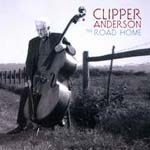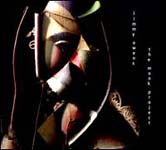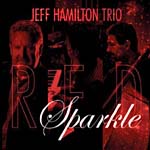|
|
|
CLIPPER ANDERSON
 The
Road Home The
Road Home
Origin
Records
By Tom
Ineck
It is
evident from the first lines of the opening track, Bill Evans’ “Twelve
Tone Tune Two,” that this is the bassist’s record. Despite the
considerable talents and sensitive interplay of pianist Darin Clendenin
and drummer Mark Ivester, Anderson’s prodigious playing skill and
booming, woody tone have an immediate impact on the listener.
The leader
also impresses as the composer of six of the 11 tracks, including the
lovely and lyrical title tune, a shimmering pastoral evocation of the
Pacific Northwest where Anderson lives. “Esperancoso Destino”
(Portuguese for “Hopeful Destination”) is as bright and hopeful as its
title and features a wordless vocal by Greta Matassa. Clendenin states
the melody of the beautiful ballad “Say Yes Again,” but Anderson
contributes the perfect bass harmonies and solos with grace and
imagination. The loping, mid-tempo “Nasty Gnomes” is a rhythmic gem, and
“Can You Meet Me There?” is another heartfelt ballad. Like the title
track, “Two Rivers” again evokes a rural journey. As the composer
acknowledges in the liner notes, both tunes were influenced by Pat
Metheny.
In addition
to the original compositions, the cover tunes are well chosen. Richard
Rodgers’ “Over and Over Again” is taken at a brisk waltz tempo, aided by
Ivester’s brush work. Anderson’s performance, including the introductory
bowed section, on Jack Brownlow’s “Jimnopodie” brilliantly echoes Erik
Satie’s haunting “Gymnopedies” that inspired it. “Poinciana” gets a
wonderful trio treatment, with Clendenin stating the simple, but
familiar melody as Anderson plays counterpoint and Ivester provides
energetic percussion on both drums and congas. Piano and bass combine
unison lines for a powerful ending. Appropriately, Bill Evans’ ballad
“Only Child” makes a nice bookend for the CD, and Anderson renders the
lyrics with feeling.
With a
strong debut like this, veteran bassist Clipper Anderson deserves more
attention as a leader.
top |
|
|
|
JIMMY OWENS
 The
Monk Project The
Monk Project
IPO Recordings
By Tom
Ineck
The recent release of “The Monk Project”
proves that trumpet and flugelhorn artist Jimmy Owens is under-recorded.
He shines here in the company of an all-star ensemble that includes
trombonist Wycliffe Gordon, saxophonists Marcus Strickland and Howard
Johnson, pianist Kenny Barron, bassist Kenny Davis and drummer Winard
Harper. You could not assemble a more formidable—or more
compatible—group of musicians to revisit the always fascinating music of
Thelonious Sphere Monk.
“The Monk Project” bubbles with
enthusiasm from the get-go, the typically quirky Monk tune “Bright
Mississippi.” The brass is imaginatively voiced from top to bottom, and
everyone is given ample room to solo. Owens, the nominal leader,
produced the recording and wrote the arrangements, but this is a very
democratic project, indeed. The result is an ensemble sound that moves
as one.
Barron contributes a stunning solo on a
loping Latin arrangement of “Well You Needn’t,” followed by Owens on a
long, under-stated solo on flugelhorn. Harper’s drum fills are
priceless. “Blue Monk” retains all of its slow-drag blues credentials,
complete with slurred trumpet blasts by Owens, plunger-muted trombone as
only Gordon can deliver, and Strickland’s tenor sax wailing in the grand
tradition.
Owens turns up the whimsy on “Stuffy
Turkey,” featuring dizzily swirling, chuckle-inducing horn lines.
“Pannonica” gets an appropriately tender ballad reading, with Owens’
flugelhorn and Gordon’s trombone blending beautifully and the other
horns adding harmonic spice. As always, Barron’s piano contributions are
well-considered and tasteful. “Let’s Cool One” is a very cool and jazzy
uptempo waltz.
“Reflections” is a trio performance with
Owens at his most meditative as he delivers a soulful flugelhorn
statement in tandem with Gordon’s trombone. Barron provides sensitive
accompaniment. The ensemble returns in full force for the final piece,
an 11-minute version of “Epistrophy.”
Owens arranges with a flair for various
time signatures and tempos, but his love and respect for Monk’s
one-of-a-kind sound is evident in every note. “Brilliant Corners” was
brilliantly arranged by Ayal Vilner and Ellington’s “It Don’t Mean a
Thing (If It Ain’t Got That Swing)” was transcribed and arranged by Jack
Ramsey from Monk’s performance with Oscar Pettiford and Kenny Clarke on
“Thelonious Monk Plays Duke Ellington.”
top |
|
|
|
JEFF HAMILTON TRIO
 Red
Sparkle Red
Sparkle
Capri
Records
By Tom
Ineck
There is no
more swinging drummer in jazz today than Jeff Hamilton. He has both the
power to drive a big band and the subtlety to finesse a lyrical trio
like this one, with pianist Tamir Hendelman and bassist Christoph Luty.
Often utilizing brushes only, Hamilton creates an irresistible rhythmic
pulse but never distracts from his colleagues’ important melodic and
harmonic roles. Actually, he has such a keen sense of melody and mood
that he seems to make the drums sing rather than just provide a beat.
Together
for a decade under Hamilton’s leadership, this threesome is uncannily
coherent and cohesive. They give new perspective on standards like the
uptempo “Too Marvelous for Words,” the ballad “Laura” and the whimsical
“A Sleepin’ Bee,” which features some devilishly difficult stop-time
exchanges. Hendelman and Luty excel on this tune, but it is Hamilton
whose breezily swinging brush strokes hold it all together.
Hendelman
and Luty state the melody of Monk’s quirky “Bye Ya” in unerring unison
before venturing into solo excursions, and the trio smartly reinterprets
the Stephen Bishop pop hit “On and On.” One of the most beautiful
performances is on the ballad “I Know You Oh So Well,” by Hamilton’s
former employer, the late Ray Brown, with Luty on bowed bass.
The four
original compositions are equally impressive. Hamilton’s shuffle tune
“Ain’t That a Peach” is a bright and swinging opener that really gets
the adrenaline moving. Hendelman offers “Hat’s Dance,” a relaxed,
mid-tempo swinger with bluesy echoes of Oscar Peterson. Luty’s
contribution is “In an Ellingtone,” an obvious reference to Duke and his
classic “In a Mellotone.” The exciting title track is Hamilton’s nod to
those special “red sparkle” moments in music—and in life—named for the
finish on his very first drum kit. Everyone turns it up a notch on this
one.
top |
|
|
|

 The
Road Home
The
Road Home The
Monk Project
The
Monk Project Red
Sparkle
Red
Sparkle